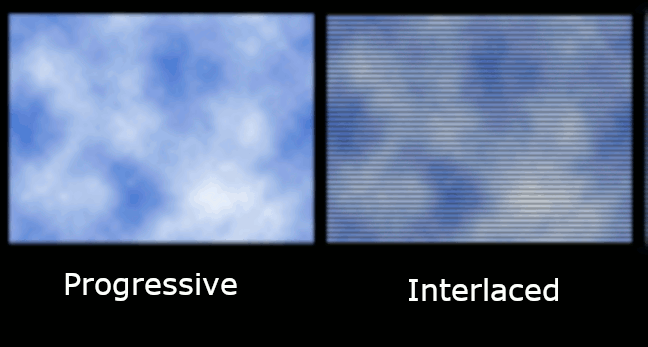Interlaced Scanning
The visual appearance of a temporally sampled video sequence can be improved by using interlace video. To improve the visual appearance without increasing the data rate, the video sequence is composed of fields. For a video sequence with temporal rate of 25 Hz (i.e., 25 complete frames of video per second), the video sequence is composed of fields at a rate of 50 Hz. Each filed contains half of the lines that make up a complete frame i.e., the odd and even numbered lines from the frame are placed in two separate fields, each containing half the information of a complete frame. These fields are captured and displayed at 1/50th of a second intervals and result in an update of 50 Hz, with the data rate of a signal at 25 Hz.
Video that is captured and displayed in this way is known as interlaced video and generally has a more pleasing visual appearance than video transmitted as complete frames (progressive video). Because each field happens so quickly we are given the illusion of a whole image.
Because you’re only capturing half of the image at a time, movement within the frame (due to either camera movement or subject movement) may cause motion artifacts. This happens especially when the movement is quick enough to cause noticeably different positions of the fields.
Video sources that are listed with the letter i are called interlaced. An example of this would be 480i. Interlaced video displays even and odd scan lines as separate fields. The even scan lines are drawn on the screen, then the odd scan lines are drawn on the screen. Two of these even and odd scan line fields make up one video frame.
Progressive Scanning
Progressive scanning captures entire image per frame. It results in a clearer image and handles movement differently. It does not have artifacts which are present in interlaced scanning.
Progressive video is more expensive but desired. The scanning technique results in the clearest images without worrying about too many artifacts. It also allows for better viewing of fast motion video like in action sequences in movies and sports.
Video sources that are listed with the letter p are called progressive scan signals. Examples of this would be 480p. Progressive scan video content displays both the even and odd scan lines on the screen at the same time.

Summary
The recording, playback and transmission of video used either progressive or interlaced techniques. Interlaced has its roots in the broadcasting industry and is still widely used because of its efficiency and reliability. Progressive is ideal for higher quality displays for smoother video output.
For example, a video sequence consists of 50 fields per second and when played back, motion appears smoother than in an equivalent progressive video sequence containing 25 frames per second. When video is captured in one format (e.g. interlaced) and displayed in another (e.g. progressive), it is necessary to convert between formats.
